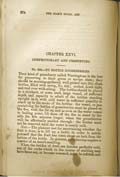That kind of gooseberry called Warringtons is the bes4 for preserving in their green or unripe state; they should be morning-gathered, well-picked into dry, clean bottles, filled with syrup, No. 842; corked down tight, and tied over with string. The bottles should be placed in a stockpot, or some such large vessel, of sufficient depth and capacity to admit of the bottles standing upright in it, with cold water in sufficient quantity to reach up to the necks of the bottles: the vessel, or pan containing the bottles of gooseberries must be placed on the fire, with the lid on, and as soon as the water comes to boiling point, lift them off the fire to stand by the side for five minutes longer, when the gooseberries will be effectually scalded through: the bottles must not be removed until the water is nearly cold.
Note.—The plainest test for ascertaining whether the fruit is done, is to lift up a bottle in order to satisfy yourself that the fruit has risen about an inch from the bottom of the bottle. In general, gooseberries require a quarter of an hour's scalding.
When the bottles of fruit are become perfectly cold, any of the corks which in the course of scalding may have burst out, or become loosened, must be refitted, and tied down afresh; and the nozzle of each bottle must be dipped in hot bottle-wax. When all are satisfactorily finished, let them be put away in the cellar, binned up in the same order as is customary with bottles of wine.
Note.—The bottle-wax must be melted with bees'-wax, at the rate of one ounce of bees'-wax to one pound of bottle-wax.
I strongly recommend that green-wax should never be used for any of these purposes, as it contains corrosive poison in its composition; and however careful persons may be while removing the wax previously to drawing, the cork, it may easily happen, that some unperceived portion of the green wax may find its way into the fruit, and occasion serious mischief. All other coloured wax is harmless.
